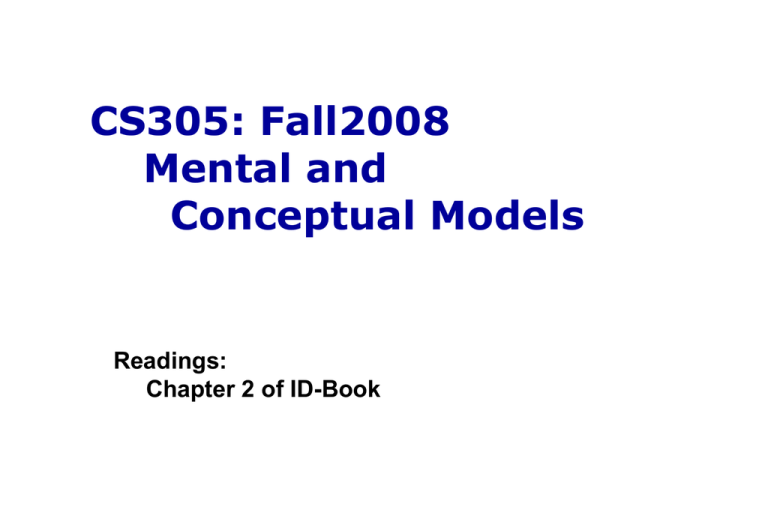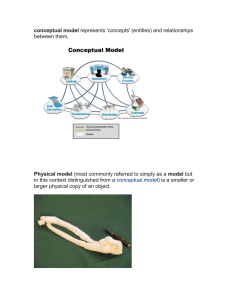CS305: Fall2008 Mental and Conceptual Models Readings:
advertisement

CS305: Fall2008 Mental and Conceptual Models Readings: Chapter 2 of ID-Book Topic Outline • Conceptual models – Mental models – Metaphors • Interaction styles • Heading towards… Prototyping, design Mental and Conceptual model • Need to first think about how the system will appear to users (i.e. how they will understand it) • A conceptual model is a high level description of: – “the proposed system in terms of a set of integrated ideas and concepts about what it should do, behave and look like, that will be understandable by the users in the manner intended” Mental Models • Also hear term mental model. Same? • Norman: – “The models people have of themselves, others, the environment and the things with which they interact. People form mental models through experience, training, and instruction.” • Often a more specific idea than conceptual model – I.e. focuses on a specific system For either idea…. • You want to understand what the user already has in their head • Then, you want to: – Maybe build your system in response to this – Work to create a different model in their head as they use your system • Always keep in mind when making design decisions how the user will understand the underlying model Understanding a conceptual model • How will the user think about the system? – Based on data, functions, a metaphor? • Are there existing systems, concepts that will influence how the user will think about the system? • What kind of interface metaphor, if any, will be appropriate? • What kinds of interaction modes and styles to use? • Breakdowns? – ISIS example and back-button Question? • What’s a “portal”? – What’s that mean to you? • Example of a high-level conceptual model? Discuss • What possible high-level conceptual models are there for… • Help system for: – Large photo management application OR – VLSI/CAD/component diagramming tool • Room reservation system • Radio recording application • A few slides back we said: • How will the user think about the system? – Based on data, functions, a metaphor? • Next: – Models based on functions (how we interact with the system) – Then, metaphors Conceptual models based on activities • Giving instructions – issuing commands using keyboard and function keys and selecting options via menus • Conversing – interacting with the system as if having a conversation • Manipulating and navigating – acting on objects and interacting with virtual objects • Exploring and browsing – finding out and learning things 1. Giving instructions • Where users instruct the system and tell it what to do – e.g. tell the time, print a file, save a file • Very common conceptual model, underlying a diversity of devices and systems – e.g. CAD, word processors, VCRs, vending machines • Main benefit is that instructing supports quick and efficient interaction – good for repetitive kinds of actions performed on multiple objects 2. Conversing • Underlying model of having a conversation with another human • Range from simple voice recognition menudriven systems to more complex ‘natural language’ dialogues • Examples include timetables, search engines, advice-giving systems, help systems • Recently, much interest in having virtual agents at the interface, who converse with you, e.g. Microsoft’s Bob and Clippy Pros and cons of conversational model • Allows users, especially novices and technophobes, to interact with the system in a way that is familiar – makes them feel comfortable, at ease and less scared • Misunderstandings can arise when the system does not know how to parse what the user says – e.g. child types into a search engine, that uses natural language the question – Let’s try it! Something like a conversation… • Can you think of a common technique in GUI based applications where – A series of interactions happen – Questions/responses guide what happens from one step to the other • Your answer is? • Is this like a conversation? Shares any characteristics? 3. Manipulating and navigating • Involves dragging, selecting, opening, closing and zooming actions on virtual objects • Exploit’s users’ knowledge of how they move and manipulate in the physical world • Exemplified by – what you see is what you get (WYSIWYG) and – the direct manipulation approach (DM) • Shneiderman (1983) coined the term DM, came from his fascination with computer games at the time Core principles of DM • Continuous representation of objects and actions of interest • Physical actions and button pressing instead of issuing commands with complex syntax • Rapid reversible actions with immediate feedback on object of interest Advantages of DM • Give me some! Why are DM interfaces so enjoyable? • Novices can learn the basic functionality quickly • Experienced users can work extremely rapidly to carry out a wide range of tasks, even defining new functions • Intermittent users can retain operational concepts over time • Error messages rarely needed • Users can immediately see if their actions are furthering their goals and if not do something else • Users experience less anxiety • Users gain confidence and mastery and feel in control What are the disadvantages with DM? • Some people take the metaphor of direct manipulation too literally • Not all tasks can be described by objects and not all actions can be done directly • Some tasks are better achieved through delegating – e.g. spell checking • Can become screen space ‘gobblers’ • Moving a mouse around the screen can be slower than pressing function keys to do same actions 4. Exploring and browsing • Similar to how people browse information with existing media (e.g. newspapers, magazines, libraries, pamphlets) • Information is structured to allow flexibility in way user is able to search for information – e.g. multimedia, web Conceptual models based on objects • Usually based on an analogy with something in the physical world • Examples include books, tools, vehicles • Classic: Star Interface based on office objects Johnson et al (1989) Another classic: the spreadsheet (Bricklin) • Analogous to ledger sheet • Interactive and computational • Easy to understand • Greatly extending what accountants and others could do www.bricklin.com/history/refcards.htm Spreadsheet metaphors • Do users of Excel – Think of ledgers? – Use it to do “what if” analyses? • What do we do? • Keep lists! • What tasks are useful for lists? – – – – Sort by column Filter by criteria Summarize See Data menu in Excel Lotus Improv Which conceptual model is best? • Direct manipulation is good for ‘doing’ types of tasks, e.g. designing, drawing, flying, driving, sizing windows • Issuing instructions is good for repetitive tasks, e.g. spell-checking, file management • Having a conversation is good for children, computer-phobic, disabled users and specialised applications (e.g. phone services) • Hybrid conceptual models are often employed, where different ways of carrying out the same actions is supported at the interface - but can take longer to learn Interface metaphors • Interface designed to be similar to a physical entity but also has own properties – e.g. desktop metaphor, web portals • Can be based on activity, object or a combination of both • Exploit user’s familiar knowledge, helping them to understand ‘the unfamiliar’ • Conjures up the essence of the unfamiliar activity, enabling users to leverage of this to understand more aspects of the unfamiliar functionality Examples of Metaphors • Gimme some! – Button – Folders in a GUI – Icons like disk, print, etc. – Window controls (max, close, min) – Window – view into something bigger – Paint apps: canvas, color wheel/chooser, brush, spraypaint can, etc. – Notepad (used for jotting quick docs) – Mouse-over on web: hand, cross-hair • Task bar (like spread-out desk, pull open paper, one on-top) • Sticky notes • Speaker for volume control. Slider bar like hi-fi equipment • Powerpoint slides • Tabbed interfaces Examples of Metaphors • Last term’s examples – OneNote – notebook – Paint (easel, brushes,…) – Calculator – Email (letters! INBOXES – MediaPlayer like CD player – Word processor – like a typewriter – Trash can on desktop – Folders, filecabinets Examples of Metaphors • Last term’s examples! – – – – – – – – – – – – – Sticky notes DVD players looks like a real HW device Bird takes pizza order OS X dashboard (overall view of system) Piece of paper in word processor etc. First-person shooter games Paintbrush tool in graphics apps Shopping cart on website Bookmarks Bulletin board system Recycle bin / trashcan gmail’s conversations / also chatting briefcase Benefits of interface metaphors • Makes learning new systems easier • Helps users understand the underlying conceptual model • Can be very innovative and enable the realm of computers and their applications to be made more accessible to a greater diversity of users Problems with metaphors? • Give me some examples! Problems with interface metaphors • Break conventional and cultural rules – e.g. recycle bin placed on desktop • Can constrain designers in the way they conceptualize a problem space • Conflict with design principles • Forces users to only understand the system in terms of the metaphor • Designers can inadvertently use bad existing designs and transfer the bad parts over • Limits designers’ imagination in coming up with new conceptual models Conceptual models: from interaction mode to style • Interaction mode (what we discussed before): – what the user is doing when interacting with a system, e.g. instructing, talking, browsing or other • Interaction style: – the kind of interface used to support the mode, e.g. speech, menu-based, gesture Interaction Styles • A physical UI be built upon various mechanisms – Command line – Menu selection – Form-fill – Direct manipulation • mouse, pen, etc. – Anthropomorphic • Voice, ink (Tablet PCs) Which interaction style to choose? • Need to determine requirements and user needs • Take the budget and other constraints into account • Also will depend on suitability of technology for activity being supported • This topic will be covered more later when discuss how to actually design conceptual models Conclusion: What’s the relevance of all this? • Conceptual and mental models – Users bring existing models with them – You can leverage this or create a new model for your system – May lead to high-level conceptual model for your interface • Interaction Mode and Interaction Style – What’s the high-level way a user interacts with a new system? (Why? What’s the benefit?) – Is there a high-level metaphor / model? – Can lower-level metaphors be used in lower-level UI design?



